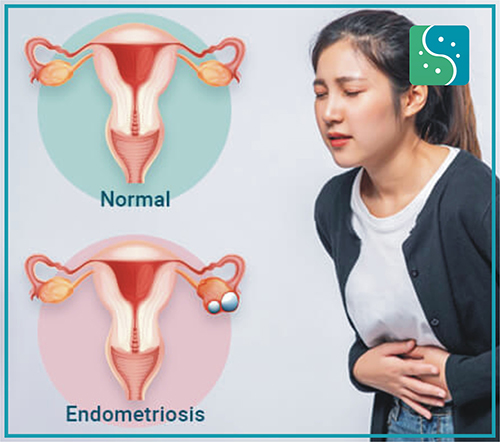ENDOMETRIOSIS (en-doe-me-tree-O-sis) is an often painful disorder in which tissue similar to the tissue, that normally lines the inside of your uterus, the endometrium; grows outside your uterus. Endometriosis most commonly involves your ovaries, fallopian tubes and the tissue lining your pelvis. Rarely, endometrial like tissue may be found beyond the area where pelvic organs are located.
Homoeopathic remedies are prescribed by symptoms rather than conditions, as each case of a particular illness can manifest differently in different people. This is the only way through which a state of complete health can be regained by removing all the sign and symptoms from which the patient is suffering. The aim of homoeopathy is not only to treat endometriosis but to address its underlying cause and individual susceptibility.
As far as therapeutic medication is concerned, several remedies are available to treat endometriosis that can be selected on the basis of cause, sensations and modalities of the complaints.
The endometrium is the inner lining of your uterus. This tissue is what you shed during a menstrual period. Think of endometrium as layers of tissue that build up along the inside lining of your uterus. When you have a period, these layers fall away from the walls of your uterus and leave your body. If you get pregnant, the endometrium helps support the early phases of development.
When you have endometriosis, endometrial like tissue grows on other organs or structures. This tissue can grow within your abdomen, pelvis or even chest. This tissue is hormonally sensitive and can become inflamed during your menstrual cycle. These areas of endometrial like tissue can cause ovarian cysts, superficial lesions, deeper nodules, adhesions (tissue that connects your organs and binds them together) and scar tissue within your body.

The cause of endometriosis is unknown. When you have endometriosis, tissue similar to the lining of your uterus grows in the wrong places. When it develops in places like the outside of your uterus, fallopian tubes, ovaries, intestine and within your pelvic cavity, it can cause painful symptoms. This pain is related to increased inflammation and often fibrosis and adhesions.
Endometriosis is a complex disease that affects many women globally from the onset of their first period (menarche) through menopause, regardless of ethnic origin or social status. Many different factors are thought to contribute to its development. At present endometriosis is thought to arise due to:
Other factors may also contribute to the growth or persistence of ectopic endometrial tissue. For example, endometriosis is known to be dependent on estrogen, which increases the inflammation, growth and pain associated with the disease. However, the relationship between estrogen and endometriosis is complex since the absence of estrogen does not always mean the absence of endometriosis.
Endometriosis often causes severe pain in the pelvis, especially during menstrual periods. Some people also have pain during sex or when using the bathroom. Some people have trouble getting pregnant.
Some people with endometriosis don’t have any symptoms. For those who do, a common symptom is pain in the lower part of the belly (pelvis). Pain may be most noticeable:
Some people also experience:
Symptoms often improve after menopause, but not always.
Endometriosis has significant social, public health and economic implications. It can decrease quality of life due to severe pain, fatigue, depression, anxiety and infertility. Some individuals with endometriosis experience debilitating pain that prevents them from going to work or school. Painful sex due to endometriosis can lead to interruption or avoidance of intercourse and affect the sexual health of affected individuals and their partners. Addressing endometriosis will empower those affected by it by supporting their human right to the highest standard of sexual and reproductive health, quality of life and overall well-being.

A careful history of menstrual symptoms and chronic pelvic pain provides the basis for suspecting endometriosis. Although several screening tools and tests have been proposed and tested, none are currently validated to accurately identify or predict individuals or populations that are most likely to have the disease. Endometriosis can often present symptoms that mimic other conditions and contribute to a diagnostic delay. Ovarian endometrioma, adhesions and deep nodular forms of disease often require ultrasonography or magnetic resonance imaging (MRI) to detect. Histologic verification, usually following surgical/laparoscopic visualization, can be useful in confirming diagnosis, particularly for the most common superficial lesions.
Endometriosis isn’t a condition you can necessarily prevent. There are certain factors that can reduce your risk of developing the condition, but in some cases, you may still have endometriosis. There could be a genetic reason that some people develop endometriosis. If other people in your family (mother or grandmother) have been diagnosed with endometriosis, consult your doctor about your risk of also developing the condition.
A few factors that can reduce your risk of endometriosis include:
Living with Endometriosis can cause you to experience long-term (chronic) pain, heavy periods and difficulties getting pregnant. You can manage these symptoms by taking homoeopathic medicines. Homoeopathic treatment can help improve your daily life and manage your endometriosis over the long haul. The aim of homoeopathy is not only to treat endometriosis but to address its underlying cause and individual susceptibility. As far as therapeutic medication is concerned, several remedies are available to treat endometriosis that can be selected on the basis of cause, sensations and modalities of the complaints.